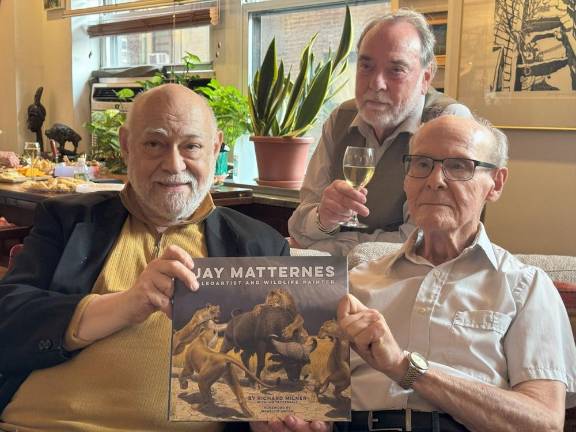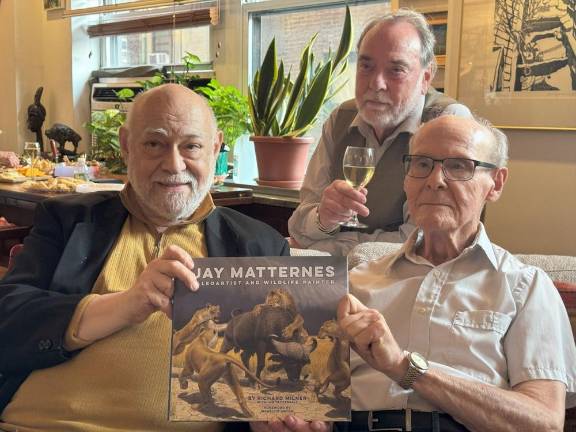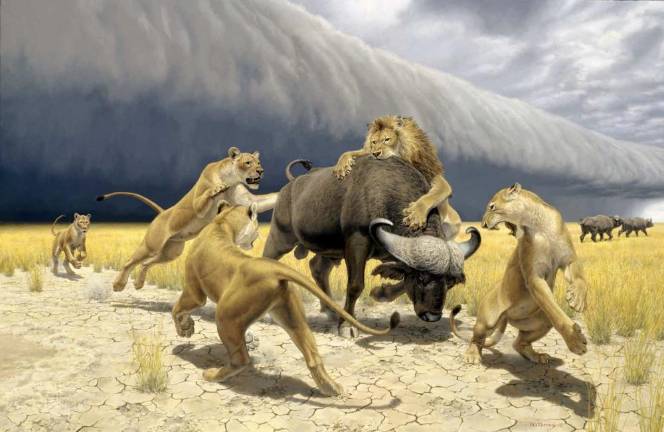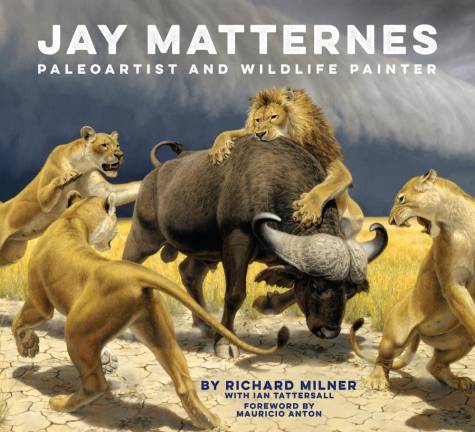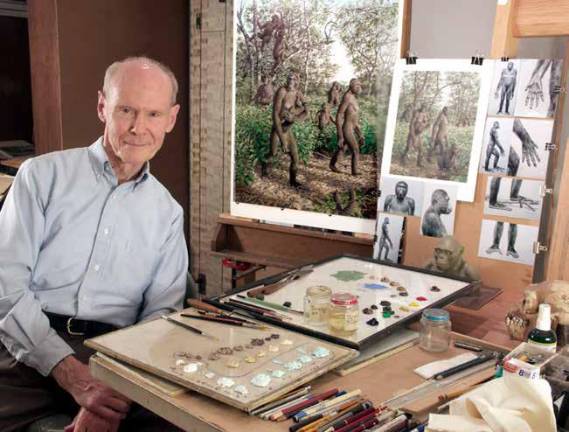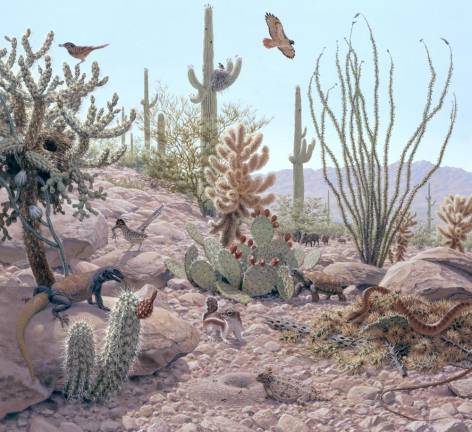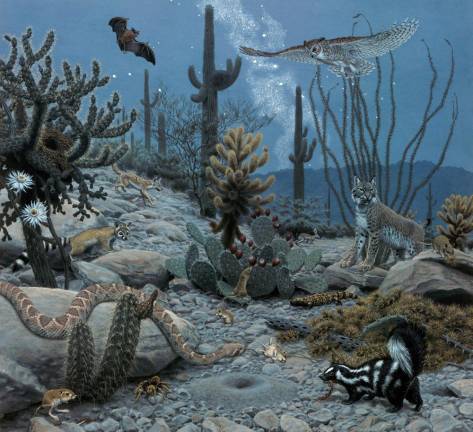Everyone is “Wild” About New Book Featuring Fabled Wildlife Painter Matternes
It should come as no surprise that the just released tome ”Jay Matternes Paleoartist and Wildlife Painter,” is an artsy table top book. Our literary contributor caught up with the artist and his two writing partners at a book launch party on the UWS recently and learned how it all came about.
A Paleoartist, a Paleoanthropologist, and an Anthropologist walk into a book party...
Artist Jay Matternes and co-authors Ian Tattersall and Richard Milner, who spearheaded the collaboration, celebrated recently the New York launch of their impressive title: Jay Matternes Paleoartist and Wildlife Painter” published by Abbeville Press.
Designed by Rick DeMonico with the foreword written by the celebrated wildlife and Paleoartist, Mauricio Antón, the book is a work of art in and of itself.
It not only includes 91-year-old Matternes’ remarkable paintings and drawings, but documents his professional relationships with National Geographic, Jane Goodall–considered the world’s foremost expert on chimpanzees–and Dian Fossey, an American primatologist and conservationist. Fossey once marveled that until she viewed Matternes’ work: “I never could imagine what an artist could reveal about an animal that a photograph could not.”
Abbeville publisher David Fabricant says, “We saw this book as a wonderful opportunity to connect historical natural history art down to the present and publish a book on one of the major figures of the 20th Century in this field. It just seemed like a natural fit, and obviously, the merits of Jay’s work were self-evident.” He went on to call the book beautiful and important, adding that it “brings together the entire oeuvre of an artist into a comprehensive monograph so his whole achievement can be seen as it was impossible to do so before.”
Matternes, Tattersall, and Milner—whose connection came about via their individual associations with the American Museum of Natural History (AMNH)—each contributed to the project in his own way.
Obviously, the book would not exist without Jay Matternes’ artistic talents coupled with his field research done in the wilderness of Alaska, Japan, France, Colombia, and Africa. Tattersall, Curator Emeritus in the Division of Anthropology at the AMNH, offers his experience and knowledge of the subject matter, and Milner, an anthropologist, historian of science, and songwriter—his claim to fame is the one-man musical Charles Darwin: Live & In Concert—brings his writing and editing skills honed as one-time Senior Editor of Natural History magazine.
I was able to speak with all three at their well-attended event to unearth how the project came about.
Q: Jay, what drew you to this subject matter at the ripe age of 7 years old that you’ve parlayed into a successful career? A love of animals? Prehistoric times?
Jay Matternes: Both of those, really. You cannot be an effective paleontology artist unless you understand extant life forms. You have to make a certain amount of extrapolation in interpreting fossil forms, but they have to be based upon what you know about animals, and flora as well.
Q: This isn’t your first book. How does this one differ?
JM: The first was published by the Smithsonian Press of murals I had painted for the Smithsonian National Museum of Natural History. This current book’s focus is on both paleontology and my work as a wildlife artist.
Q: How did this collaboration come about?
Ian Tattersall: I’ve known Jay for many years and always knew there was a book in his art. I met Jay in the context of his work as a re-constructor of ancient humans. The visual image that we have of ancient humans really comes from what Jay first created; of what has been presented to us as the public. He has played a very important role in developing our expectations and our interpretations of what ancient humans looked like walking around the landscape.
He and I thought a book would be a good idea, but I didn’t have the time to devote to it. I asked Richard to get involved and he made it into something much more comprehensive than I could have ever imagined. And all that work has paid off big time. It’s a marriage made in heaven with Jay’s art which has an extraordinary breadth and Richard’s imagination and attention to detail.
Richard Milner: Even though Ian handed the book over to me, he stayed with the project and was available at all times. Whenever I had questions of fact—science, paleontology, anthropology—he was right there as one of my main copy editors and proofreaders. He deserves the status as third author.
Q: Richard, you not only wrote the book but took the project and ran with it. Detail the rest of the book’s journey.
RM: First off, Ian knew that Jay had painted behind the scenes for 40 years at the Smithsonian, National Geographic, and Scientific American. Millions of people knew his pictures, but nobody knew his name. Ian was determined to change that and give Jay the recognition he deserved. When I was brought in, both of us became determined to get Jay his legacy.
Jay, as meticulous an artist as he is, is not a meticulous keeper of his own archives. It took us two years to get organized before we could even start the book.
After that, it took a long time to put the book together because we kept making discoveries in Jay’s archives. I had no idea what his output was. We’ve got his amazing childhood drawings, his paintings of American Indians—a subject which is one of his passions, dinosaurs, so many things. Then there are the correspondences between Jay and Dian Fossey. Fans of hers will find it very revealing. There’s material here that they will not find anywhere else.
The book just grew organically. That is my idea of how you write a book. You don’t do some research and just throw it together. I think of myself as an artist, and when I can combine science with great art in one package, this is where I like to live.
